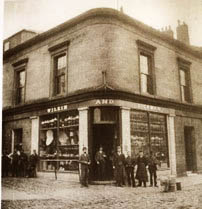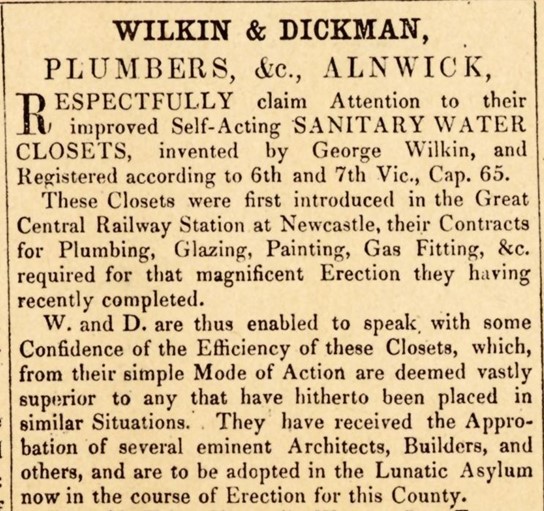Nowadays we take access to clean drinking water and efficient sanitation for granted. This was definitely not the situation in Alnwick (and anywhere else) during the early 1800’s. Human waste was often piled in the streets and backyards. Even worse, drain-off from these dung heaps leaked into the groundwater from which water pumps, and in Alnwick the “pants” drew the source of drinking water. It is no surprise that this was a time of cholera, and in Alnwick in 1849 an outbreak killed 136 citizens in a few weeks.

When it was realised that there had be major improvements in plumbing and sewage treatment, this provided a major commercial opportunity for Wilkin and Dickman plumbers of Alnwick. The business thrived. George Wilkin, the youngest son of Henry Wilkin was born at Dunstan near Craster and worked as a plumber for his eldest brother, Henry Percy Wilkin who, in partnership with William Dickman had founded the successful business in Bondgate. The firm was more than just a plumbers – it was also a blacksmiths, tinsmiths, coppersmiths, glaziers, heating engineers, watchmakers as well as a general ironmongers.
George was obviously something more than a straightforward plumber, he must have had a creative mind. George must have begun thinking about situations where regular flushing of toilets was essential, but in those days public behaviour could not be trusted to take the necessary action. As a result he devised an ” Improved Self-Acting Water Closet”. The principle appears to have been similar to those which can still be observed in many male cubicles today-that a water container slowly fills and then flushes automatically when a certain level has been reached.

George’s invention was taken up in some prominent locations. His invention was successfully installed in the Central Railway Station in Newcastle upon Tyne and was to be installed in the proposed Northumberland Lunatic Asylum to be built at Cottingwood, Morpeth. A company advertisement also shows that his invention was registered.

George’s name, however never became as well-known as an inventor is this field of social advance as, for example his Victorian contemporary, Yorkshire-born Thomas Crapper, now widely and falsely known as the inventor of the water closet. (This is supposedly because when American servicemen were stationed overseas during World War I, they reportedly noticed the word “Crapper” embossed on the cistern of nearly every toilet. Their return to the States made “crapper” a blanket term for toilets in general and the name of the supplier synonymous with its invention).
George continued working as a plumber for his brother until his death in November 1854 aged 37. Newspapers reported that “George was in the employ of his brother Henry for a long time and died rather suddenly when superintending some of the works of his brother.” George’s son Henry George Wilkin followed in his father’s footsteps, joining the firm of Wilkin and Dickman as a plumber and eventually went on to run the business.
According to a March 1864 edition of the Newcastle Journal, “Robert Burns states in his diary that on a visit to Alnwick ‘he met with a Mr Wilkin, a most ingenious man’. The family tradition has always been that the poet and Henry George – who was then surveyor to the Duke of Northumberland – spent the night in animated conversation till an early hour.” Who knew that plumbing could have been such an interest, but then perhaps Robert Burns appreciated how in the mid 1800’s good plumbing had literally been a major life-saver.

CENTRAL STATION NEWCASTLE UPON TYNE
Designed by John Dobson
With thanks to Alnwick Civic Society for their help in the material for this article

